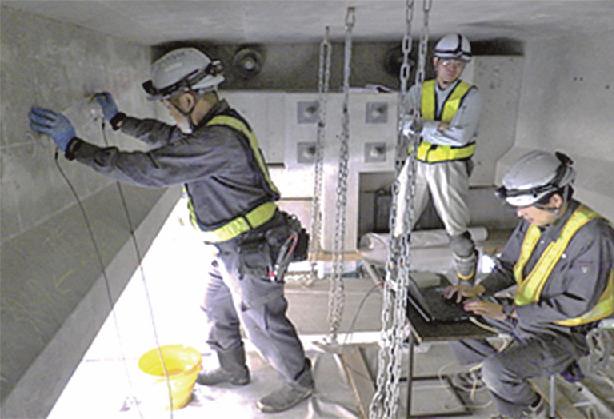Central Nippon Expressway Company/Reinforcement of salt damage countermeasures, desalination work and refilling of PC grout at Seisho Bypass Kannami Bridge

Desalinization work of Kannami Bridge

Confirmation of filling status (provided by Central Nippon Expressway Company)
Central Nippon Expressway Company will strengthen measures against salt damage at the Sounami Bridge on the Seisho Bypass (BP), which runs along the coast of Kanagawa Prefecture. In addition to desalination and surface coating work that reduce the concentration of chloride ions in concrete and improve the corrosive environment of steel materials, we will promote the development of countermeasure construction methods for refilling prestressed concrete (PC) bridge girders with PC grout. There are many places damaged by salt flying from the sea, and we are urgently working on preventive maintenance and countermeasure construction methods.
On January 27, 2021, 50 years have passed since the Seisho BP opened. The company manages the 14.5 km route between Nishisho Nishinomiya IC (Ninomiya Town) and Hakoneguchi IC (Odawara City). Most of the structures are built along the Ninomiya and Odawara coasts, and the structures are maintained in a harsh environment where they are hit by waves from typhoons.
The Tonami Bridge is a simple PC T girder bridge with a bridge length of 5,685 meters (269 spans) located near the Tachibana IC and near the Kozu IC in Odawara City. The PC bridge occupies 4,992 meters (240 spans) of extension. The damage to the girders progressed due to the salt content, and in 1991, about 20 years after the bridge opened, we started repairing the cross section and covering the surface. Surface coating work was mainly carried out in 1991-93 on 240 spans. From 1999, we started the cathodic protection work for Xixiang BP, which prevents corrosion by the potential difference of electric current.
It is difficult to manage the power receiving equipment for the Soucho Bridge, where waves reach, and from 2019, we began salt damage countermeasures that combine desalination and surface coating. After reducing the chloride ion concentration of the concrete, the surface of the concrete is covered to prevent deterioration of the concrete and internal steel materials. 54 out of 240 spans.
The purpose of countermeasures against salt damage during construction is to prevent corrosion of reinforcing bars. Canglang Bridge suffered not only corrosion of rebar but also damage to PC steel. This is because at places where the PC grout that is injected inside the sheath pipe that wraps the PC steel material is insufficient, the grout has no anticorrosion effect on the PC steel material, and the deterioration of the PC steel material and the girder progresses easily. Even areas that have undergone repair, cathodic protection, or waterproof coating will deteriorate again.
The company is investigating the filling status of PC grout and developing technology for the refilling method at Cangnan Bridge. To date, 37 out of 240 spans have been intensively investigated for PC grout, and 36 spans have been found to be underfilled, equivalent to about 13% of the more than 2,000 surveyed locations. The filling status is determined by non-destructive inspection using the broadband ultrasonic method that takes advantage of the characteristics of ultrasonic waves. After searching for reinforcing bars, the lacking parts were tested by excavating the sheath pipe from the drilled position and refilling the PC grout with a pump. We are planning to establish the necessary technical standards in the future.
Insufficient filling was unavoidable with the construction method and sheath pipe at the time of construction, but the risk of insufficient filling has decreased since 1999 due to improvements in materials and construction methods and revisions to standards. The company and the three expressway companies in East Japan and West Japan are considering how to deal with unexpected cases of deterioration, and the knowledge gained from the Tonami Bridge will be put to good use.






